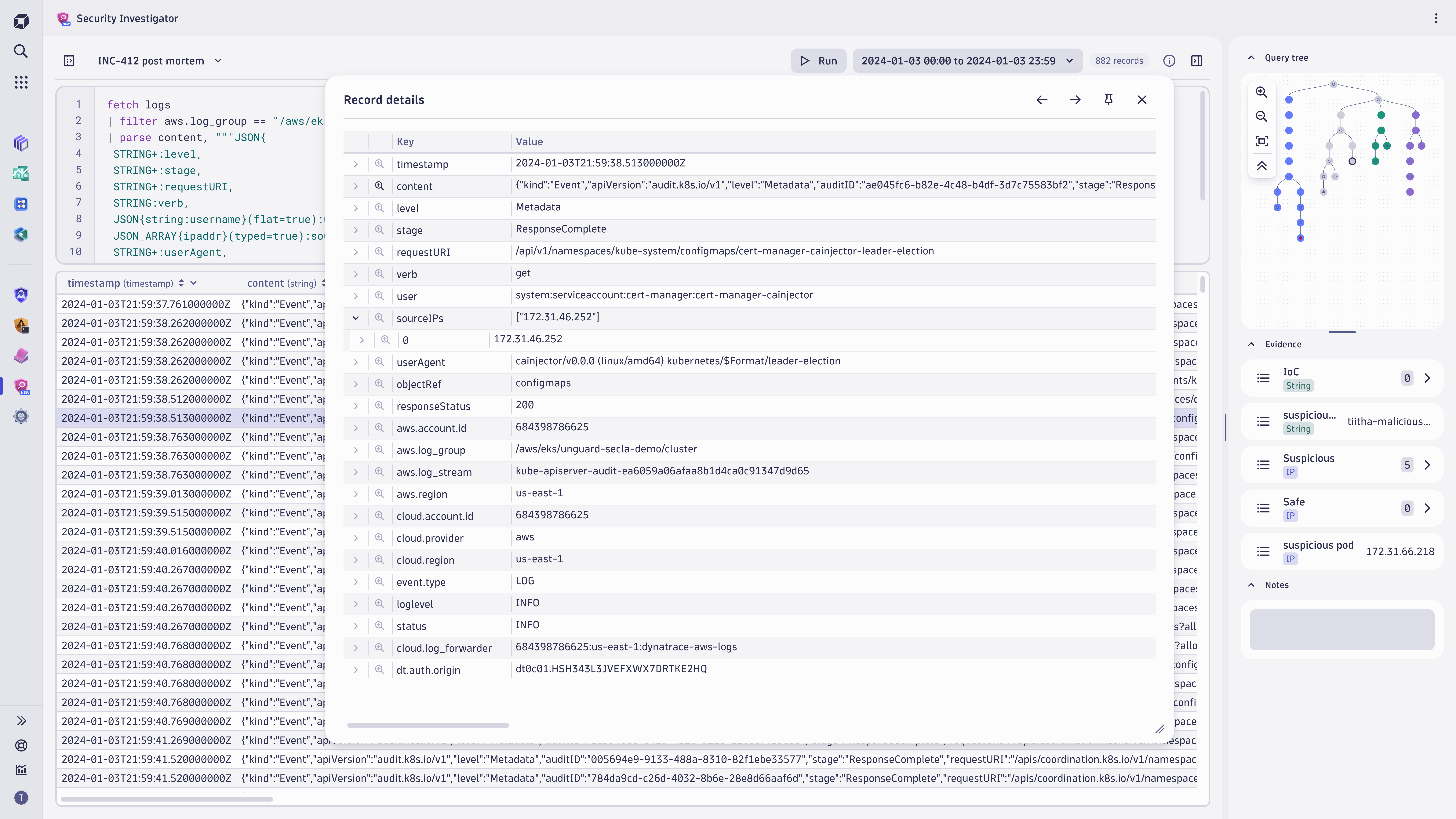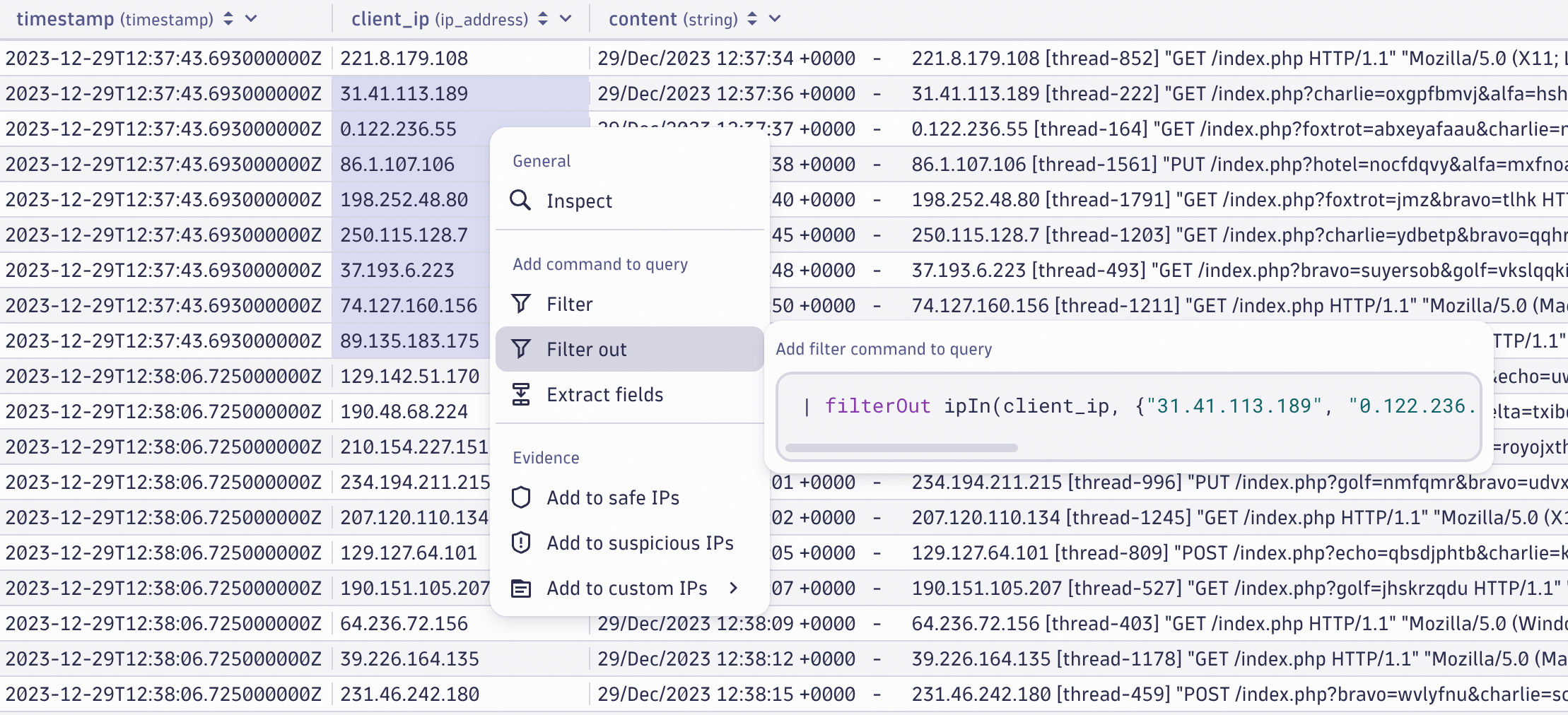Dynatrace Security Investigator is a new application on the Dynatrace platform dedicated to security operations and security analysts. The evidence-driven approach to the data in Dynatrace Grail™ enables security teams to achieve faster investigations and obtain accurate results without losing the data context of investigations. The Security Investigator app is designed for evidence-driven use cases such as threat hunting and incident solving.
As a security analyst investigating security incidents or threat hunting, you often must navigate among multiple executed queries and their respective results (in other words, investigation steps). You also need to manage the evidence you gather during investigations and reuse it when building additional queries. All this must be as fast and seamless while maintaining the investigation context.
Navigating investigations and threat hunting can involve saving executed queries and found evidence in unstructured text documents that can quickly lose their context. Manually documenting investigation steps can lead to human errors, like forgotten or wrongly documented queries or evidence, which will result in missed threats and wasted time. As the investigation grows and the different queries accumulate, it becomes harder to maintain the throughlines among the different branches.
The Dynatrace Security Investigator app provides branching navigation, making it easy to track your path through investigations.
Navigate in any direction within your investigation
Investigations in Grail are conducted using the Dynatrace Query Language (DQL). For multiple investigation steps, the Security Investigator provides a representation of the steps in a tree-like view. With this visualization, you can keep track of your investigation and navigate to previous steps and respective results in the investigation history—all in context, with no need to re-execute anything.

Every new DQL query execution creates a new descending node while keeping the integrity and hierarchy of previous queries and results unchanged.
Easily track threat-hunting twists and turns
Threat hunting is a nonlinear process. When looking for the unknown, you often stumble upon an unexpected thread of evidence that sparks a new idea and takes the investigation in a new direction. To support this nonlinear approach, we’ve created the investigation branching feature. When modifying and re-executing a previous step, the app creates a new branch while keeping the original investigation path intact and visible in the query tree.
You can create any new branches for new ideas and hypotheses while retaining the ability to navigate back to your initial train of thought. With the ability to customize and name branches, you can simplify locating historical steps without having to click through them individually.
The final visual representation provides a comprehensive overview of the entire investigation. You can see in a structured way how you reached your conclusions without needing to manually document the investigation flow.
With Security Investigator, you can always find the last working query, which was easy to lose in the past.
Character precision on a petabyte scale
Security Investigator increases the speed of investigation flows and the precision of evidence, leading to higher efficiency and faster results. Both outcomes are game-changers in time-critical situations, where answers are expected “yesterday.”
View raw content details when you need them
Data ingested into Grail is kept in its original format. A schema is applied only during query execution, or as we call it, “schema-on-read.” This makes data immune to format changes and enables you to choose your data structure based on your use cases.

The Security Investigator app enables you to view all data in its original format, regardless of the content, including characters that other tools might hide or not interpret. Enabling the multi-line content details view shows the stack traces with their line breaks in their original form, enabling you to understand the data much faster.

Find the needle in the “needle stack”
Finding a small metallic object in a stack of non-magnetic objects is relatively easy. Finding a particular object among millions of similar objects is trickier. With Security Investigator’s flexible filtering, you can create accurate DQL query filters quickly and efficiently.

If you need to fetch raw content from Grail and filter the results based on a selection of the content, you don’t need to copy partial records and manually paste them into an appropriate filter. Instead, you can easily select the portion of the text string you need and add it to your DQL query directly from the context menu.
To add multiple values to a filter, you can either select individual values or a range of values and apply them as a single filter in your DQL query. Only the unique values from the selection are added to the query, so you don’t have to investigate unneeded values.

Use your findings to enrich your investigation
With Security Investigator evidence management, you can persist relevant findings by attaching them to your investigation. Whether it is a suspicious IP address or a potential indicator of compromise, you can attach it to the investigation and use it later.
You can create type-specific filters to enable fast and accurate results, either focusing only on suspicious activities or filtering out the safe events that don’t require your attention.
Continue hunting for the unknown
Security use cases such as threat hunting and incident analysis are nonlinear, evidence-driven activities in which you don’t know what you’re looking for. You’re not pursuing a specific target; rather, you’re looking for the unknown. With Security Investigator, Dynatrace enables you to be more efficient, investigate faster, and be more precise.
Use Dynatrace Security Investigator for faster and more precise evidence-based security investigations.





Looking for answers?
Start a new discussion or ask for help in our Q&A forum.
Go to forum